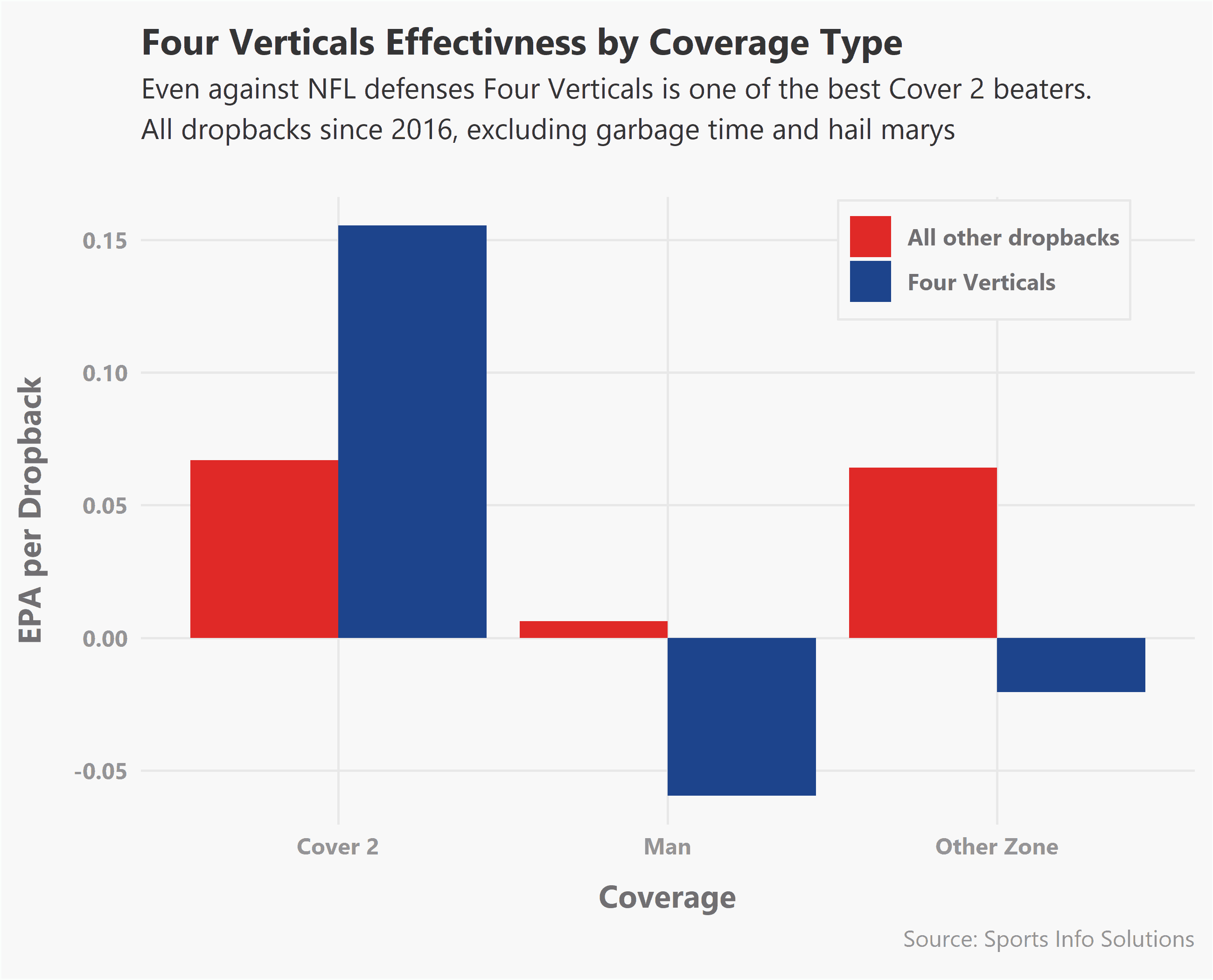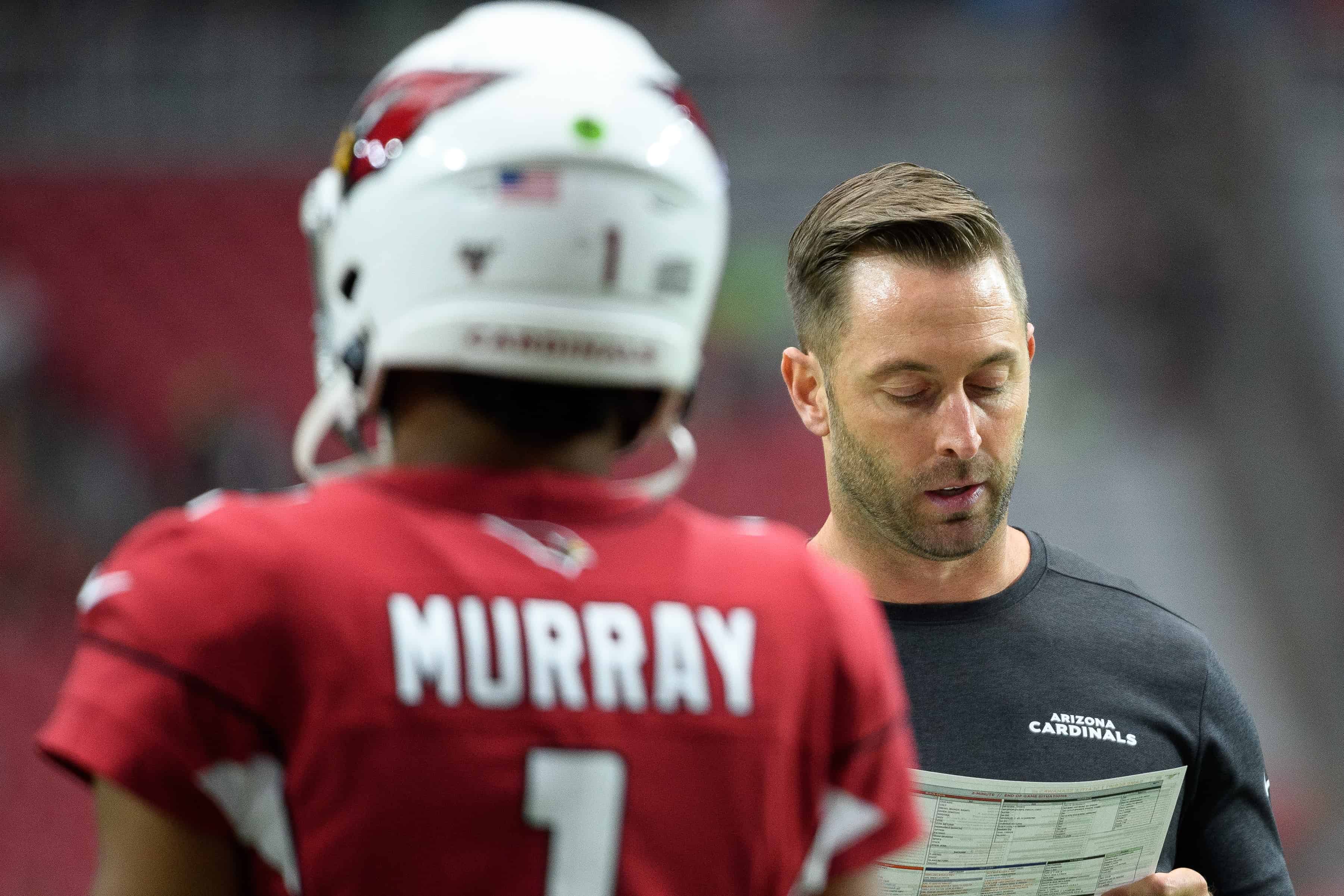NFL minds have long been resistant to the idea of Air Raid quarterbacks in the NFL. Some were concerned the reads they made in college were too simple and they wouldn’t be able to adjust to the complexities of an NFL offense. Or they never had to throw into tight windows in college, and would struggle to adjust to the tight window throws required of an NFL quarterback.
And up until now, it’s been easy enough to attribute Patrick Mahomes’s success in the NFL to him not being human, and Jared Goff’s success to head coach Sean McVay. But as more and more guys like Kyle Allen and Gardner Minshew have been able to step into NFL offenses and have early success, it’s becoming clear that writing off quarterbacks simply because they played in the Air Raid was misguided.
Some of this is because NFL teams have finally stopped trying to force these guys to be “traditional” NFL quarterbacks, and have started using concepts these players had success with in college. Hal Mumme, one of the founders of the Air Raid, put it bluntly, “Suddenly in the last five years they decided to stop trying to hammer a square peg into a round hole and started letting guys do the things they could do. Lo and behold, you’ve got guys like Mahomes and Goff.” The RPO boom has been talked about more heavily on broadcasts, but there are plenty of “college” passing concepts as well that are starting to become more and more prevalent in the NFL.
Mesh
The Mesh Concept is a fundamental part of any Air Raid offense. The basic idea is that inside receivers on each side of the line run shallow crossing routes as close to each other as possible, creating a natural “pick” that the defense needs to navigate. Because of that natural pick Mesh is particularly effective against man coverage, but the horizontal stretch it creates also allows it so have success against zone.
The Browns’ first quarter touchdown against the Ravens in Week 4 is a perfect example of the stress Mesh puts on defenders. No. 13 Odell Beckham sets the mesh-point, No. 83 Ricky Seals-Jones runs his shallow cross underneath, and the defenders get lost in the chaos leaving Seals-Jones wide open for an easy touchdown.
Using Sports Info Solutions’ charting data, we can look at all drop backs that used the Mesh Concept dating back to 2016. Overall, the Expected Points Added per Drop back (EPA/D) for Mesh is 0.10, which is far better than the league average EPA/D of 0.03. Mesh also had a slightly higher than average Positive% (the percent of plays that resulted in a positive EPA value) at 51%.
| EPA/D | Positive% | ADoT | |
|---|---|---|---|
| Mesh | 0.1 | 51% | 5.1 |
| All Other Dropbacks | 0.03 | 47% | 8 |
There are other things that need to be taken into account when evaluating Mesh though as it is disproportionately run on third downs and in short yardage. Given that these are higher leverage situations, this can skew things like EPA and Positive%. When looking only at early downs though, the numbers look even better.
Despite having an average depth of target (ADoT) nearly a full three yards lower than the average throw on early downs, the mesh concept actually has a slightly higher Boom% (the percentage of plays with an EPA greater than one) than all other early down passes. It also has an EPA/D that nearly triples all other pass plays and converts first downs more often.
The trend is even more clear when broken down into each individual down. (For those concerned about sample size, each group has at least 200 plays.)

The average distance to go when Mesh is called on third down is only 4.9, compared to 7.8 for all other dropbacks, which may lead one to believe that it is only effective in short yardage. But even splitting third downs into short, medium, and long, Mesh still has higher success rates than typical dropbacks in all groups. Across the board, Mesh is a concept that is incredibly hard to defend.
This all solidifies Mesh as a legitimate concept in the NFL on its own, but it’s also noteworthy that the concept actually appears to be more effective in the NFL than in college. Mesh is run more frequently in college, but doesn’t stand out from a typical drop back. The EPA/D is only 0.01 higher when running Mesh, and while the Boom% is still higher in college, so is the Bust% (the percentage of plays with an EPA less than negative one).
Y-Cross
The Y-Cross Concept has a number of variations, but in general involves the receiver out wide on the front side running a vertical route, #2 to the front side running an outward-breaking route, and the Y on the backside running a deep cross.
Evan Engram’s 75-yard touchdown against the Bucs in Week 3 is a perfect example of the concept, and also shows why it can be particularly effective against zone coverage. On the play, No. 86 Darius Slayton is running a 9-route, No. 87 Sterling Shephard runs an out, and No. 88 Engram is running the cross. The Bucs are in Cover 3. The deep third player on the front side runs with Slayton, the Curl/Flat player takes Shephard, and Engram finds a soft spot in the zone behind the linebackers who were frozen by play action.
The Y-Cross Concept is not as prevalent in the NFL as Mesh, but has seen a large increase in usage in both 2017 and 2018 after being used sparsely in 2016. In the relatively small sample we have, it has been very effective.
The EPA/D when running Y-Cross is about double that of an average drop back, and has proven to be an effective way to attack the deeper portions of the field. The ADoT is 11.7, almost four yards above the league average, and the Boom% and Y/A are both higher than that of a league-average dropback.
| EPA/D | ADoT | Y/A | |
|---|---|---|---|
| Y-Cross | 0.07 | 11.7 | 8.8 |
| All other dropbacks | 0.03 | 8 | 7.2 |
Y-Cross is particularly effective against zone. The EPA/D for Y-Cross is 0.15 against zone, tripling the league average drop back. The Y/A of 9.7 is more than a full two yards better than league average, and it also has both a higher Boom% and lower Bust%.
Like Mesh, all of these numbers compare favorably to the college version. With the only discernible difference being that Y-Cross has both a higher ADoT and a higher Boom% when run in college, indicating that college quarterbacks are even more aggressive attacking downfield. This isn’t any kind of indictment on the concept in the pros though, and speaks more to the differences in the game between the college and pro level.
Four Verticals
Four Verticals may be most well-known for its dominance in Madden, but it is also at the center of every Air Raid playbook. The goal is to stretch the defense vertically by running four players down the field on 9-routes. Players also have the option to cut their routes off at any point based on the cushion or leverage they’re seeing from the defense.
This example from the Chiefs’ 2018 game against the Steelers shows a basic version of the concept, and is a good example of how it stresses defenders in zone coverage, in this case, Tampa 2.
On the aggregate, Four Verticals doesn’t appear to have nearly as much success in the pros as it does in college, and actually looks fairly inefficient. The EPA/D is minus-0.02, which is 0.05 lower than an average drop back, and despite having an ADoT five yards above the league average, the Boom% is only two points higher.
This doesn’t mean that Four Verticals isn’t working at the pro-level though. When breaking it down by coverage type you can see why—four Verticals has been very successful against Cover 2.

Four Verticals is decidedly more effective in college than in the pros. It has an EPA/D of 0.22 overall, which is almost a full quarter-point better than the average drop back. Against Cover 2 it has an even more ridiculous EPA/D of 0.35, and is still good against man, posting an EPA/D of 0.10. The Boom% is also drastically higher across all splits in college.
What this really means though is that defensive backs in the NFL are much better than they are in college. Especially against man, it is not realistic to expect receivers to win as consistently on 9-routes as they do in college. And even against zone, safeties are much smarter and faster at the NFL level. But even still, Four Verticals clearly has its uses in the pro game.
Final Thoughts
There are other Air Raid concepts that weren’t mentioned, but these are meant to be illustrative of a larger point: NFL teams are already using Air Raid concepts, and they are using them effectively.
The Air Raid was originally invented in order for smaller schools with less talent to be able to keep up with elite teams. In a league where finding talent at the most important position has been so elusive for so many teams, it only makes sense that teams should be looking to make up for the gap in talent with more creative schemes. And there may not be a better place to start than the scheme that was designed to do just that.
We will likely never see a full-on Mike Leach offense in the NFL. Even Kliff Kingsbury appears to be bringing a slightly watered-down and NFL-ized version of his Texas Tech playbook to the Cardinals, and that’s fine. But teams should continue to try and work in some of these concepts that have worked so well at lower levels of football.
















